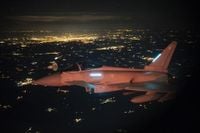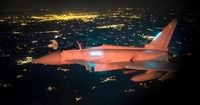On Friday night, September 19, 2025, the skies above Poland buzzed with the unmistakable sound of Royal Air Force Typhoon jets, a powerful symbol of NATO solidarity in the face of escalating Russian aggression. The British fighters, call signs “Chaos 1-1” and “Chaos 1-2,” lifted off from RAF Coningsby in Lincolnshire, supported by a Voyager air-to-air refuelling aircraft, to begin their first air defence mission under NATO’s Eastern Sentry operation. Their task: patrol Polish airspace and send a clear message to Moscow—NATO airspace will be defended, no matter the cost.
This deployment was no routine sortie. The decision came after a series of alarming incidents that have pushed Europe closer to open conflict than at any time since World War II. On September 10, 2025, Poland reported the incursion of 19 Russian drones, launched from Belarus, into its airspace. Polish forces responded swiftly, shooting down several of the drones—a move that marked the first direct military action by NATO forces against Russian assets since the war in Ukraine erupted in 2022, according to The Independent.
The gravity of the situation was not lost on Polish Prime Minister Donald Tusk, who warned, “We are now the closest to open conflict since World War II.” His words echoed across the continent, stirring memories of a Europe once torn apart by war and now facing the specter of renewed hostilities. The Polish government immediately invoked NATO’s Article 4, triggering urgent consultations among member states about the growing threat on the alliance’s eastern flank.
Britain’s Defence Secretary John Healey was unequivocal in his support for Poland and the wider alliance. “RAF Typhoons have now flown their first air defence mission over Poland, sending a clear signal: NATO airspace will be defended,” Healey declared, as reported by Metro. “I’m proud of the outstanding British pilots and air crew who took part in this successful operation to defend our Allies from reckless Russian aggression.” The mission, he added, was especially poignant as it coincided with the 85th anniversary of the Battle of Britain—a reminder of the enduring bonds between the UK and its European partners.
The RAF deployment was part of a broader, coordinated response by NATO to a series of Russian provocations. In the days leading up to the British sortie, Russian military aircraft violated the airspace of both Estonia and Romania. Estonia’s Ministry of Defence reported that three Russian MiG-31 fighter jets entered its airspace over the Gulf of Finland for a full 12 minutes—a brazen act described by Estonian officials as “unprecedented.” NATO responded by scrambling Italian F-35s stationed in the region, while Russia insisted its planes had only flown over international waters.
These incidents have rattled nerves across Europe. Czech President Petr Pavel, himself a former army general, voiced the growing sense of urgency: “What has happened in recent days in Poland, Estonia, what has been happening in Ukraine for the fourth year is a matter for all of us, because if we do not stand together, sooner or later it will happen to us too.” He went further, stating, “If Russia behaves aggressively then NATO must respond in kind. And that includes a military response. Russia will very quickly realize that it has made a mistake and has crossed acceptable boundaries. Unfortunately, it is teetering on the edge of conflict, but it is simply impossible to give in to evil.”
The UK’s involvement in the Eastern Sentry mission is part of a wider strategy to reinforce NATO’s eastern borders. Air Chief Marshal Harv Smyth, Chief of the Air Staff, emphasized, “Our partnership with NATO has never been stronger. This sortie marks the RAF’s first operational mission on Eastern Sentry, reinforcing the UK’s steadfast commitment to NATO and its allies. RAF Typhoons, supported by Voyager air-air refuelling aircraft, joined allies along the eastern flank to bolster NATO’s defence and deterrence. We remain agile, integrated, and ready to project airpower at range.”
The Eurofighter Typhoon, a key asset in the RAF’s quick reaction alert force, is designed for exactly this type of mission—rapid deployment and robust air defence. The UK has signaled its intent to further strengthen its military capabilities, announcing plans to increase defence spending to 2.6% of GDP by 2027. This move, according to BBC and The Independent, is intended to reinforce Britain’s contribution to NATO operations and ensure that the alliance remains ready to meet any threat.
But the military response is just one part of the West’s strategy to counter Russian aggression. The UK government, along with its European partners, is also exploring economic measures to support Ukraine and deter Moscow. Chancellor Rachel Reeves announced that Britain is considering using the profits from frozen Russian assets to provide loans to Ukraine—a move designed to bolster Kyiv’s war effort without breaching international law. “This is Russia’s war, and Russia should pay. It is right to explore all options to support Ukraine. Defending against Russian aggression is vital not just to the long-term security and prosperity of Ukraine, but to the UK and the whole of Europe,” Reeves said.
The debate over how best to use these frozen assets is ongoing. Some, like former Defence Secretary Ben Wallace, have called for the government to go further and directly seize Russian funds to finance Ukraine’s defence. The Liberal Democrats have echoed this call, while the Treasury is considering a so-called “reparations loan” that could unlock billions of pounds for Ukraine without directly confiscating Russian property.
Meanwhile, the situation on the ground in Ukraine remains dire. According to Ukrainian President Volodymyr Zelensky, a recent Russian air attack involved 580 drones and 40 missiles targeting infrastructure, civilian manufacturing companies, and residential areas. “Every such strike is not a military necessity but a deliberate strategy by Russia to terrorise civilians and destroy our infrastructure,” Zelensky stated. Russia, for its part, denies targeting civilians.
Across Europe, the sense of urgency is palpable. Deputy Prime Minister David Lammy assured the public that Britain, “combined with 27 countries, of course, we can face down Putin, he knows that, and I want to reassure you that whilst we take this seriously, he understands that he will be up against a very, very serious effort.”
As the RAF jets returned to their base in the early hours of Saturday, September 20, their mission complete, the message from NATO was unmistakable: the alliance stands united, ready to defend its members against any threat. With tensions running high and the specter of open conflict looming, the world watches closely—hoping that deterrence, not escalation, will prevail.


